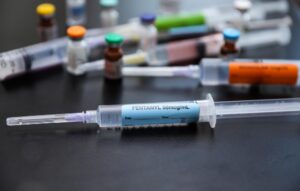Understanding the Challenge of Fentanyl Addiction
Fentanyl is a synthetic opioid that is up to 50–100 times more potent than morphine. While it has a legitimate medical use in managing severe pain, it has increasingly entered the illicit drug market—often unbeknownst to the user—because it’s frequently mixed with other illicit substances like heroin, cocaine, or counterfeit pills. Even a tiny amount can be fatal, leading to dangerously high rates of dependence, overdose, and death.
Because of this drug’s potency, treating fentanyl addiction, recovery requires more than willpower—it requires expert medical care, compassionate support, and evidence-based treatment. At Hygea Healthcare, our mission is to make that care accessible and effective for every individual ready to reclaim their life.
Getting help for fentanyl addiction can feel overwhelming, but taking the first step doesn’t have to be complicated. Below, we’ve outlined simple, practical steps to help you access safe and effective treatment.

Step 1: Recognize the Signs
Recognizing the warning signs of fentanyl misuse or addiction is the first step toward getting help.
Physical indicators:
- Constricted (“pinpoint”) pupils
- Slowed breathing
- Extreme drowsiness or sedation
- Nausea, vomiting, or diarrhea
Behavioral or emotional changes:
- Intense cravings or compulsive use
- Neglecting work, family, or responsibilities
- Continuing use despite negative consequences
Tolerance and withdrawal:
- Needing more of the drug to feel “normal”
- Experiencing chills, muscle aches, anxiety, or insomnia when not using
If these symptoms sound familiar, it’s time to reach out for professional help. Hygea Healthcare’s licensed specialists can guide you through a safe and personalized treatment path.
Step 2: Reach Out for Professional Help
Once you’ve recognized that fentanyl use has become unmanageable, the next step is to connect with qualified addiction professionals who can guide you toward the right treatment option.
At Hygea Healthcare, our care team helps individuals and families understand their options and connect with trusted treatment pathways that fit their unique needs and comfort level.
This step may include:
- Speaking with an addiction specialist or care coordinator to discuss symptoms and treatment goals.
- Learning about available levels of care
- Getting support in creating a personalized treatment plan that aligns with your physical, emotional, and lifestyle needs.
You don’t have to figure it all out alone — Hygea Healthcare is here to help you take that first step safely and confidently.
Step 3: Medical Detoxification
Because fentanyl withdrawal can be severe, medical detox is often the safest first step. Attempting to quit without supervision can be dangerous.
At Hygea Healthcare, individuals are connected with qualified medical professionals who can monitor symptoms, manage withdrawal safely, and ensure comfort and stability.
- Medications may be used to reduce cravings and stabilize symptoms.
- Hydration, nutrition, and rest are prioritized.
- The focus is stabilization, laying the foundation for ongoing treatment.
Detox is an important beginning — but it’s only the first phase of fentanyl addiction treatment.
Step 4: Continue with Evidence-Based Treatment
Following detox, effective treatment for fentanyl addiction integrates multiple dimensions:
Behavioral Therapies and Counseling
Evidence-based therapies such as Cognitive Behavioral Therapy (CBT), substance abuse counseling, motivational interviewing, and family or peer support help individuals identify triggers, rebuild relationships, and develop healthier coping strategies. These therapies are vital for changing thought patterns and behaviors linked to addiction.
Holistic Support and Alternative Therapies
Recovery also means restoring balance to the body and mind. Many people benefit from integrating mindfulness, yoga, exercise, and nutritional guidance to strengthen emotional resilience and promote overall well-being.
Medication-Assisted Treatment (MAT)
For some individuals, Medication-Assisted Treatment using medications like Buprenorphine, Methadone, or Naltrexone can be a helpful tool to manage cravings, reduce withdrawal discomfort, and lower the risk of relapse.
Step 5: Choose the Right Program
When selecting a fentanyl addiction treatment program, consider:
- Accredited, experienced providers in treating opioid addiction
- Comprehensive services that include detox and long-term recovery options
- Supportive, inclusive environments that encourage family participation
- Transparent insurance and payment options
Hygea Healthcare connects clients with trusted treatment programs that provide the care and environment necessary for meaningful, lasting recovery.
Step 6: Commit to Ongoing Recovery
Recovery from fentanyl addiction is a continuous journey, not a single event. Long-term success comes from commitment, connection, and support.
Hygea Healthcare helps individuals stay on track with:
- Healthy routines that support stability and wellness
- Relapse-prevention planning and trigger management
- Peer and community support for accountability
- Encouragement to view setbacks as opportunities for growth, not failure
- Aftercare planning to ensure long-term recovery
Recovery is possible — and every step forward is progress.
Take the First Step with Hygea Healthcare
If you or someone you love is struggling with fentanyl addiction, help is available right now. Hygea Healthcare offers personalized, compassionate support to help you begin the path toward healing.
Reach out today to learn how we can help you find safe, effective treatment and lasting recovery.

